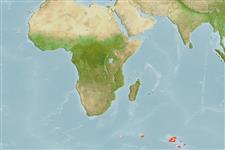Environment: milieu / climate zone / depth range / distribution range
Ecologia
marino demersale; distribuzione batimetrica 0 - 91 m (Ref. 11892). Polar; 46°S - 54°S
Southern Ocean: Kerguelen and Crozet Islands; littoral and deeper waters of Heard Island.
Size / Peso / Age
Maturity: Lm ? range ? - ? cm
Max length : 8.2 cm TL maschio/sesso non determinato; (Ref. 11892)
Short description
Chiavi di identificazione | Morfologia | Morfometria
Spine dorsali (totale) : 3 - 5; Raggi dorsali molli (totale) : 21 - 24; Raggi anali molli: 15 - 19.
Found under rocks on the beach or in tide pools, but may also be found deeper (down to 80 m) among kelp and other algae (Ref. 5191). Feed on small crustaceans and common in littoral of all sub-Antarctic islands (Ref. 42041).
Life cycle and mating behavior
Maturità | Riproduzione | Deposizione | Uova | Fecundity | Larve
Hureau, J.-C., 1990. Harpagiferidae. p. 357-363. In O. Gon and P.C. Heemstra (eds.) Fishes of the Southern Ocean. J.L.B. Smith Institute of Ichthyology, Grahamstown, South Africa. 462 p. (Ref. 5191)
IUCN Red List Status (Ref. 130435: Version 2024-2)
Threat to humans
Harmless
Human uses
Strumenti
Special reports
Download XML
Fonti Internet
Estimates based on models
Preferred temperature (Ref.
123201): 2.9 - 3.8, mean 3.2 °C (based on 18 cells).
Phylogenetic diversity index (Ref.
82804): PD
50 = 0.5010 [Uniqueness, from 0.5 = low to 2.0 = high].
Bayesian length-weight: a=0.00525 (0.00206 - 0.01336), b=3.10 (2.88 - 3.32), in cm total length, based on LWR estimates for this (Sub)family-body shape (Ref.
93245).
Trophic level (Ref.
69278): 3.2 ±0.5 se; based on size and trophs of closest relatives
Resilienza (Ref.
120179): Medio, tempo minimo di raddoppiamento della popolazione 1.4 - 4.4 anni (Preliminary K or Fecundity.).
Fishing Vulnerability (Ref.
59153): Low vulnerability (10 of 100).
